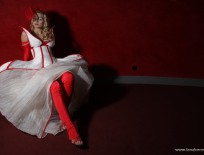Les Liaisons dangereuses 2009

Thesis defence 2009
Topic – History as inspiration for film and theatre
Dangerous Liaisons (Choderlos de Laclos)
Dangerous Liaisons (Les Liaisons dangereuses) “Is the novel of a French writer Choderlos de Laclos. After its first publication in 1782, it gained a lot of attention for its open criticism of manners and relationships among certain social classes. There are almost 200 letters in which the author tells the story of two libertine aristocrats – Viscount de Valmont and Marquise de Merteuil. All they want to do is play with feelings of other people. They shamelessly seduce and immediately after that condemn their innocent victims. However, they soon become dangerously involved in their own schemes.”
There were more reasons for choosing this novel as topic for my thesis. From the artistic point of view, this novel takes place in the attractive Rococo period. In the past years, it was adapted for screen both in a traditional and also in a modern way. The novel was also dramatised for the theatre. It therefore covers the whole assignment and at the same time it enables a wide range of interpretation and production.
After considering the way of conception, I decided to focus on the form of scenic costume. The reasons for my decision were firstly my inclination to theatre and secondly because this type of visual art varies a lot from the typical catwalk model or custom-made production.
The designer here helps the audience to picture the surroundings and atmosphere of the story and also the characteristics of the protagonists.
The interpretation itself depends naturally on the scene the given play is presented on. People expert something else from Ballet, Opera, Alternative theatrical styles, or a Chamber scene. After some thinking, I chose to set my work in a smaller theatrical scene. Here I could base everything on the rococo topic (to some point monumental). At the same time, however, I could use some modernisation and general simplifying of the line.
At this point, the characters become important. This thesis discusses three complete models of three characters that picture the given situation perfectly. The first person is Marquise de Merteuil, the second Viscount de Valmont and the third is Cecile Volanges
(a typical example of all women who trusted the Marquise and were seduced by the Viscount).
Three different characteristics can be concluded from these three protagonists: Cecile, a young and beautiful girl, naïve and helpless in understanding the higher plays and games; Marquise de Merteuil, a wolf in sheep’s clothing, an excellent plotter of her aristocratic time; and Viscount de Valmont, a predator and seducer that becomes tame at the end of the story (he actually becomes the sheep in wolf’s clothing).
As the criteria of the theatre differ from the film, the costumes must be
easy-to-maintain and they should also help the actors to express their character only by the definition of its existence. The purity of expression is concerned as well as clarity for the whole theatre. I admit that my interpretation focused on using the ideal materials (Lycra, Brocade, Duvetyn, or Satin), wire constructions for better idea of rococo shapes and ports, and drawing as a decorative element.
The white brocade is used as a basic material that unites all characters. The white that symbolises innocence and purity should be mentioned everywhere, at a gentleman’s shirt and also in the rococo construction of both women characters. May it serve as essence of the character, or its disguise. The second colour is red. The marquise’s underdress is made from this colour. It serves as her second skin and her substance. This colour is partly used at the Viscount as well. The colour of his coat stands for his pose for the public. Cecile is the only one who wears blue. This sets her apart from other main characters and shows that she is not part of the main plot. Her character completes the surroundings of the main characters and a certain naivety of first sight perceiving.
I hope that the colour palette, construction based on period sources as well as the expression my works have, help everybody to understand my intended aims. It may also open the world of the theatrical scenic costume to those, who are not interested in this sphere very much. And should I have raised your interest, I am glad that my work was not fo










